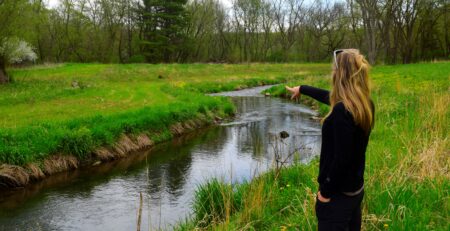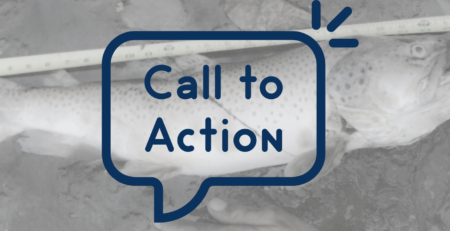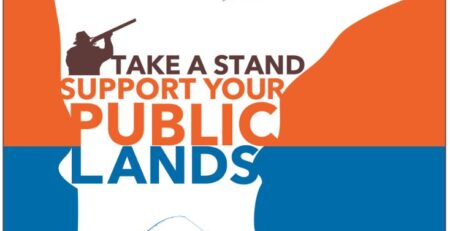Responsible Mining: A Roadmap for Mining Critical Minerals
A Roadmap for Mining of Critical Minerals and Sulfide Ore Deposits
For the past ten years the possibility of a new type of mining in northeast Minnesota has consumed the energies of environmentalists, conservationists, businesses, agencies, and politicians at all levels of government. The debate about whether, where and how to permit the mining of precious metals from sulfide ore deposits, which can generate fundamentally different pollution than iron mining, rages on. Can “sulfide mining” be done responsibly in northeast Minnesota? A recent report by Trout Unlimited and coalition partners on “critical minerals” offers a framework for answering this question.
Sulfide Mining Differs from Iron Mining
Polymet Mining and Twin Metals Minnesota are proposing to operate coppernickel mines in hard rock formations composed of sulfide ores. These are not Minnesota’s traditional iron ore and taconite mines, but a new type of toxic producing mine which would extract minerals from sulfide ores. The character of the rock in which iron is mined is very different from sulfide bearing rock. Iron ore is mined from iron oxide deposits which are chemically inert and non-toxic. In contrast, the sulfide ores from which copper, nickel, cobalt, and other nonferrous metals are proposed to be mined are unstable when unearthed. When sulfides are exposed to water and oxygen they react to produce sulfuric acid and poison the water. The potential for sulfuric acid drainage to pollute our waterways, lakes and groundwater is what has Minnesota Trout Unlimited and thoughtful anglers and citizens very concerned.
Critical Minerals
In August 2020 Trout Unlimited, National Wildlife Federation and Backcountry Hunters & Anglers released their Critical Minerals Report: A Conservation Perspective, in response to the Trump Administration’s push to develop and implement a “Federal Strategy to Ensure Secure and Reliable Supplies of Critical Minerals.” Find the TU report online: www.tu.org/critical-mineralsreport-conservation-perspective The Commerce Dept. report can be found at: www.commerce.gov/sites/default/ files/2020-01/Critical_Minerals_ Strategy_Final.pdf Since these minerals are found in the same sulfide ores as copper and nickel, their extraction raises the same issues. Strategies to avoid and minimize impacts to trout and salmon habitats across the country are thus applicable in northern Minnesota and the Great Lakes basin.
What are Critical Minerals?
Critical minerals are those defined by Executive Order 13817 as non-fuel minerals essential to the economic and national security of the nation, the supply chains of which are vulnerable to disruption. These 56 minerals and metals include recognizable ones like titanium, aluminum, helium, lithium, and cobalt, and dozens of obscure ones. As TU notes: “Critical minerals are found extensively in everyday life. They’re in the car you drive, the cell phone you scroll through, wind turbines and solar panels generating electricity, and the television giving you a weather forecast and the news each morning. They’re used in airplanes, precision guided missiles and submarines. Importantly, they are also vital components for renewable energy technologies that can help address climate change and its associated consequences for fish and wildlife habitat. They are, as their name implies, critical to the national and economic security of the United States. But their extraction and production comes with impacts.”
The Impetus to Develop the Report
In December 2017, President Trump issued Executive Order 13817, which directed the Commerce Department to develop a report that includes: (1) a strategy to reduce the Nation’s reliance on critical minerals; (2) an assessment of progress toward developing critical minerals recycling and reprocessing technologies, and technological alternatives to critical minerals; (3) options for accessing and developing critical minerals through trade with allies; (4) a plan to improve mapping and data access to support private sector exploration of critical minerals; and (5) recommendations to streamline permitting and review processes related to leases, and increase discovery, mining and refining of critical minerals. The last item in particular caught TU’s attention.
In June 2019 the Commerce Department issued its report which included ways to develop critical mineral recycling and reprocessing (a good thing), but also recommendations to “streamline” permitting to develop extraction leases. As TU observed:
“Of specific note to anglers, hunters and outdoor recreationists of all stripes, the report included 61 recommendations, including calls to action affecting public lands and watersheds. These include revising public land planning processes, streamlining environmental reviews, and seeking recommendations to reduce ‘unnecessary’ impacts that protected public lands like wilderness areas and National Monuments have on mining.”
Trout Unlimited recognized the complexity of the issue and the need to offer a thoughtful framework for collaborative solutions to avoid or minimize impacts to trout and salmon watersheds and wild, roadless places.
Acknowledging the Need for Critical Minerals and Some Mining
This is a complex issue and everyone should review the very readable Critical Minerals Report: A Conservation Perspective. At the risk of oversimplifying, TU, NWF and BHA concluded that:
• We do need critical minerals, especially as key components of renewable energy development/storage.
• Critical minerals are therefore vital to mitigating climate change.
• We cannot solely mine our way out of supply chain challenges–we need to reduce demand and recycle first.
• After using the best efforts to reduce demand and increase recycling, the U.S. still will need to develop some new mines.
• If done strategically and responsibly, mining critical minerals (and all minerals) can be done in a way at appropriate locations that protect vital habitat and treasured natural resources.
Coldwater Resources at Risk
TU used a team of experts to map and identify areas of critical mineral deposits with a nexus to important fish and wildlife habitats and protected public lands. They concluded that of the known critical mineral deposits, half are within coldwater trout and salmon habitat! And one in ten are located in currently protected wilderness areas and Forest Service roadless areas. “This analysis also means that half of the known deposits are not within coldwater habitat, providing an opportunity to consider developing these resources while avoiding highvalue locations.” In the report is a link to a map-based search tool you can use to see where trout and salmon habitat could be at risk. The February 2014 edition of this newspaper contained a map of northern Minnesota trout waters at risk, produced by our frequent partner, the Minnesota Center for Environmental Advocacy. Since the locations of potential threats have changed little in the past seven years, and no one has made new coldwater streams or lakes since the glaciers receded, the map remains accurate and is reprinted above.
Tenets for Responsible Critical Minerals Development
Drawing on decades of involvement in protecting public lands and roadless areas, participating in public resource planning and permitting review processes, and helping to reclaim abandoned mines, TU offers 12 tenets for responsible development of critical minerals:
1. Before seeking new sources of raw materials, prioritize and fully utilize alternatives, such as recycling, substitutes to critical minerals, reprocessing old mine waste piles and ash material, and engineering advancements to reduce use and need for new mines.
2. Evaluate critical mineral mine site proposals on public land through transparent, effective and predictable public processes–ones that include public land users, affected communities and indigenous tribes, as well as appropriate state and local governments and other stakeholders.
3. Avoid and minimize critical mineral development impacts to important fish and wildlife habitat, including focusing operations on landscapes that already have established infrastructure.
4. Encourage federal and state policies that support responsible critical minerals mining and avoid impacts to special places, recreational assets and high quality fish and wildlife habitat. Where impacts are unavoidable, effects must be mitigated including through the use of compensatory mitigation.
5. Ensure that environmental safeguards, such as the National Environmental Policy Act and current public land protections, are not circumvented, repealed or weakened for the purposes of developing critical minerals.
6. Utilize the best available science to map critical mineral resources, identify key fish and wildlife habitat, and develop avoidance and mitigation strategies.
7. Where critical minerals are a byproduct of other mining objectives, enforce all applicable laws–including those that govern non-critical minerals–to ensure uniformity of policy.
8. To be considered “critical,” minerals should be subject to import vulnerability, not just import reliance. Supplies from some allies may be part of secure supply chains, even if those minerals are imported.
9. Some places are simply too special or sensitive to mine. Where other values are deemed more important and risks too high, critical mineral mine proposals should not be approved.
10. Allocate a portion of the revenues generated from mineral development on public lands, including critical minerals, to offset expenses for mitigation and abandoned mine reclamation.
11. Develop new policies in formalized collaboration with all affected stakeholders, including hunters and anglers, tribes, outdoor recreation interests, labor, manufacturers and the mining industry.
12. Seek to build enduring trust, transparency, and partnership with all stakeholders and impacted communities, which should result in more responsible mining projects, and reduced community opposition.
Application to Northeast Minnesota
Copper, nickel and gold are not on the critical minerals list. Yet, efforts to extract them from the sulfide ore formations can have the same impacts and raise the same concerns. If followed, the tenets can avoid and minimize impacts to trout and salmon habitats in northern Minnesota and the Great Lakes basin. The Boundary Waters Canoe Area Wilderness is highlighted as one place “simply too special or sensitive to mine” (tenet 9). The watersheds “upstream” of the BWCAW are extremely water-rich and the risks high.
Thirteenth Tenet for MN?
Minnesota Trout Unlimited believes that all mining projects, including in sulfide ore bodies, must have adequate protections to prevent pollution and proper financial safeguards to ensure any future pollution will be fully remediated. While the tenth tenet gets at this financial aspect, it may not go far enough in water rich Minnesota. It is important that the state receive a significant up front, cash damage deposit before operations begin. The actual impacts of a mine may be far greater if the financial resources are not adequate or not controlled solely by state regulatory agencies. If funds are too small or their expenditure delayed, the responsiveness or thoroughness of corrective measures can be compromised and lead to impacts larger. We cannot assume that the State will have independent financial resources available to address environmental impacts if financial assurances prove to be inadequate. If project proposers truly pay all costs of a mine operation, including after mining ceases, we suspect mining companies will choose other sites further away from sensitive water resources.
Can “Sulfide Mining” be Done Responsibly in Northeast Minnesota?
If the tenets above are implemented, the chances of avoiding and minimizing impacts to trout, steelhead and salmon habitats in the Lake Superior and Boundary Waters watersheds are good. The challenge is translating this roadmap into specific state policies and permit recommendations. Several partners with greater resources than MNTU have been doing a great job leading the fight to protect our northern waters from mine pollution. We hope to increase our participation on these issues. We encourage individual TU members to follow and comment on sulfide mining proposals using MN DNR and MPCA websites.



